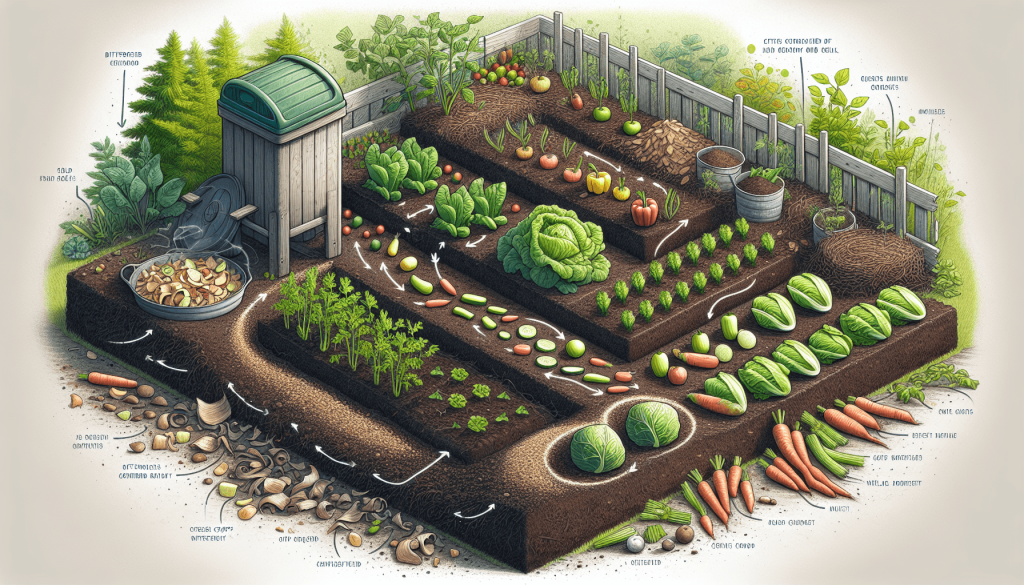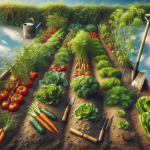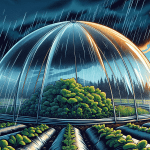This post may contain affiliate links. As an Amazon Associate, we may earn commissions from qualifying purchases.
Are you struggling with poor soil quality in your garden? Don’t worry, you’re not alone. Many gardeners face this common problem, but the good news is that there are several simple and effective ways to improve it. By implementing practices such as adding organic matter, adjusting pH levels, and practicing proper watering and mulching techniques, you can transform your lackluster soil into a nutrient-rich foundation for your plants to thrive. So, roll up your sleeves and get ready to give your garden the soil upgrade it deserves!
Testing the Soil
Testing the soil in your garden is the first step in improving its quality. Understanding the composition of the soil is essential to determine its pH level and nutrient content. By conducting soil tests, you can gain valuable insights into the health and fertility of your garden soil.
Understanding the Soil Composition
Soil is made up of various components such as sand, silt, clay, organic matter, and minerals. The relative proportions of these components determine the soil’s texture and structure. Sandy soils drain quickly but may lack nutrients, while clay soils retain water but can become compacted easily. Loamy soils, which have a balanced mixture of sand, silt, and clay, are considered ideal for gardening.
Conducting Soil Tests
Soil tests can be done using DIY test kits or by sending samples to a professional laboratory. DIY kits usually provide basic information about pH levels and nutrient content, while laboratory tests offer a more detailed analysis. To obtain accurate results, ensure that you collect soil samples from different areas of your garden and at different depths. This will give you a comprehensive overview of your soil’s composition.
Interpreting Soil Test Results
Once you receive the results of your soil test, it is important to understand what they mean. The pH level indicates the acidity or alkalinity of the soil, with most plants preferring a slightly acidic to neutral pH range. Nutrient levels, such as nitrogen, phosphorus, and potassium, are also essential for plant growth. The soil test results will provide specific recommendations for any necessary amendments to improve the soil’s composition.
Amending the Soil
After testing and understanding your soil composition, it may be necessary to amend it to improve its quality. Adding organic matter, such as compost or manure, is a great way to enhance soil fertility and structure.
Adding Organic Matter
Organic matter is crucial for soil health as it provides nutrients, improves soil structure, and enhances beneficial microbial activity. By adding organic matter, you increase the soil’s water-holding capacity and nutrient retention. It also helps create a favorable environment for earthworms and other beneficial organisms.
Using Compost
Compost is a valuable source of organic matter that can be easily incorporated into the soil. It enriches the soil with nutrients and improves its ability to retain moisture. You can either make your own compost using kitchen scraps, yard waste, and other organic materials, or purchase it from garden centers. Apply compost evenly over the garden beds and mix it into the top few inches of soil.
Incorporating Manure
Manure is another excellent organic amendment for soil improvement. It is rich in nutrients and helps improve soil fertility. However, it is important to use well-rotted or composted manure to prevent the risk of introducing harmful pathogens into the soil. Mix the manure thoroughly into the soil to ensure an even distribution of nutrients.
Mulching the Soil
Mulching is an effective technique to conserve moisture, suppress weed growth, and maintain stable soil temperatures. Organic mulches, such as wood chips, straw, or shredded leaves, gradually break down and add organic matter to the soil. Apply mulch around the base of plants, leaving a gap around the stems to prevent moisture-related diseases.

Adjusting pH Levels
The pH level of soil plays a crucial role in determining plant health and nutrient availability. If your soil’s pH is too high or too low, it can hinder the growth of certain plants. By adjusting the pH levels, you can create a more favorable environment for your garden plants.
Determining pH Levels
To determine the pH level of your soil, you can use a pH testing kit or have a professional laboratory analyze your soil sample. The pH scale ranges from 0 to 14, with 7 being neutral. Values below 7 indicate acidic soil, while values above 7 indicate alkaline soil. Most garden plants prefer a pH level between 6 and 7, slightly acidic to neutral.
Lowering Soil pH
If your soil is too alkaline, you can lower the pH by adding organic materials rich in acid, such as pine needles, coffee grounds, or elemental sulfur. These amendments gradually acidify the soil over time. Regularly monitoring the pH level and reapplying the amendments as necessary will help maintain the desired acidity.
Raising Soil pH
To raise the pH of acidic soil, you can add lime or wood ashes to increase alkalinity. Lime is the most common substance used for this purpose and is available in different forms, such as agricultural lime or dolomitic lime. It is important to carefully follow the application instructions, as lime should be used sparingly to prevent overcorrection.
Improving Drainage
Proper drainage is essential for healthy plants, as excessive water can lead to root rot and other moisture-related issues. If your garden soil has poor drainage, there are several steps you can take to improve it.
Identifying Drainage Issues
To identify drainage issues in your garden, observe how water behaves after rainfall. If water puddles and takes a long time to drain, it indicates poor drainage. Additionally, waterlogged or compacted soil can become anaerobic, depriving the roots of oxygen and causing plant stress.
Amending Heavy Clay Soil
Heavy clay soil tends to have poor drainage due to its compacted nature. To improve its drainage, you can incorporate organic matter, such as compost or well-rotted manure, into the soil. This helps break up the clay particles and creates channels for water to flow through. Regularly adding organic matter over time will gradually improve the soil’s structure and drainage.
Creating Raised Beds
Another effective way to improve drainage is by creating raised beds. Raised beds elevate the planting surface above the ground level, allowing excess water to drain more efficiently. Fill the raised beds with a well-draining soil mix that consists of a balanced mixture of sand, compost, and topsoil. This will ensure optimal drainage for your plants.

Preventing Soil Erosion
Soil erosion can be a major problem for gardeners, leading to the loss of topsoil and essential nutrients. By implementing preventive measures, you can protect your soil from erosion and maintain its fertility.
Installing Retaining Walls
Installing retaining walls on sloped areas can help prevent soil erosion. These walls hold the soil in place and prevent it from being washed away during heavy rainfall or irrigation. Retaining walls can be constructed using various materials, such as bricks, stones, or concrete blocks, and can be customized to suit your garden’s aesthetics.
Using Ground Covers
Ground covers are low-growing plants that provide a protective layer over the soil, reducing erosion caused by wind and water runoff. Plants such as creeping thyme, clover, or violets are excellent choices for ground covers as they have dense foliage that helps stabilize the soil surface.
Adding Terraces
For steep slopes, terracing can be an effective way to control soil erosion. Terraces are level platforms constructed at different elevations, which slow down water flow and allow it to gradually soak into the soil. By creating terraces, you can effectively prevent soil erosion and reduce runoff.
Controlling Soil Compaction
Soil compaction can limit root growth and prevent the absorption of water and nutrients by plants. By taking proactive measures, you can prevent soil compaction and maintain healthy soil structure.
Avoiding Excessive Foot Traffic
One of the leading causes of soil compaction is excessive foot traffic, especially in small gardening areas. Try to limit foot traffic to designated paths or walkways to minimize compaction. If possible, create stepping stones or add permeable surfaces to prevent soil compaction in frequently traveled areas.
Using Raised Beds or Containers
Raised beds or containers provide an opportunity to cultivate plants without compacting the soil. By gardening in raised beds or containers, you can achieve better control over the soil’s nutrient content, moisture levels, and overall structure. This ensures optimal growing conditions for your plants and prevents soil compaction.
Applying Light Mulch
Applying a thin layer of light mulch, such as straw or wood chips, can help protect the soil from compaction caused by heavy rain or irrigation. The mulch acts as a buffer, reducing the impact of water droplets hitting the soil surface. Additionally, it helps maintain soil moisture and provides a suitable habitat for beneficial organisms that help prevent compaction.
Crop Rotation
Crop rotation is a sustainable agricultural practice that involves changing the crop grown in a specific area each planting season. By implementing crop rotation in your garden, you can promote soil health, reduce the risk of pests and diseases, and optimize nutrient availability.
Understanding Crop Rotation Benefits
Crop rotation offers several benefits for soil health. Different crops have unique nutrient requirements, and by rotating crops, you avoid depleting specific nutrients from the soil. Additionally, certain plants can fix nitrogen from the atmosphere and enrich the soil with this essential nutrient. Crop rotation also disrupts pest and disease cycles, reducing the reliance on chemical interventions.
Planning Rotation Patterns
When planning crop rotation, it is important to consider the specific nutrient requirements, growth habits, and disease susceptibilities of each plant. Group plants into different categories based on their family or nutrient requirements and ensure they are rotated properly to maximize soil health benefits. Avoid planting crops from the same family in consecutive seasons to minimize the risk of diseases and pests.
Implementing Crop Rotation
To implement crop rotation, create a rotation schedule for your garden that spans multiple planting seasons. Assign each bed or section of your garden a specific crop or crop group and follow the rotation pattern systematically. By practicing proper crop rotation, you can maintain the soil’s fertility, prevent pest and disease buildup, and promote overall garden health.
Natural Pest Control
Garden pests can be a nuisance, but relying on chemical pesticides can have negative effects on soil health and the environment. By using natural pest control methods, you can maintain a healthy balance in your garden ecosystem.
Attracting Beneficial Insects
Encouraging beneficial insects, such as ladybugs, lacewings, and praying mantises, can help control garden pests naturally. These insects feed on aphids, caterpillars, and other destructive pests, reducing the need for chemical interventions. Planting a variety of flowers and herbs that attract beneficial insects, such as dill, marigolds, and yarrow, will help create a habitat that supports biological pest control.
Utilizing Companion Planting
Companion planting is a technique where certain plants are grown together to enhance each other’s growth and deter pests. For example, planting marigolds near tomatoes can help repel aphids and nematodes. Similarly, planting basil near peppers can deter hornworms. By strategically pairing plants, you can naturally control pests and create a healthier garden ecosystem.
Using Organic Pest Control Methods
There are several organic pest control methods that can be used to tackle specific pest problems. For example, handpicking caterpillars or using insecticidal soap can help control caterpillar infestations. Neem oil, a natural pesticide derived from the neem tree, can be effective against aphids, mealybugs, and other pests. Organic pest control methods provide a safer alternative to chemical pesticides and promote the overall health of the soil and surrounding environment.
Cover Cropping
Cover cropping is the practice of planting specific crops during the non-growing season to protect and improve the soil. By incorporating cover crops into your garden rotation, you can enhance soil fertility, suppress weeds, and prevent erosion.
Choosing Suitable Cover Crops
Cover crops can vary depending on your region and specific garden goals. Leguminous cover crops, such as clover or hairy vetch, are known for their ability to fix nitrogen and enrich the soil. Grasses, like rye or oats, provide excellent weed suppression and soil structure improvement. Consider the specific needs of your garden and select cover crops accordingly.
Planting Cover Crops
Cover crops are typically planted during the periods when the main crops are not growing. Sow the cover crop seeds according to the recommended depth and spacing. Ensure good soil-to-seed contact by raking or lightly tamping the soil after planting. Additionally, provide adequate water to establish the cover crops.
Incorporating Cover Crops
Once the cover crops have matured, it is time to incorporate them into the soil. Cut down the cover crops and either till them into the soil or use them as mulch. Tillage helps break down the cover crop residues, providing organic matter and nutrients to the soil. Alternatively, you can leave the cover crop residues on the soil surface as mulch.
Conclusion
Improving the soil quality in your garden is a continuous process that requires careful attention and implementation of various techniques. By testing the soil, amending it with organic matter, adjusting pH levels, improving drainage, preventing erosion, controlling soil compaction, practicing crop rotation, utilizing natural pest control methods, and incorporating cover cropping, you can create a healthy and thriving garden. Remember to regularly monitor your soil and make adjustments as needed. With patience and dedication, your garden soil will become a nutrient-rich environment that supports the growth of vibrant and productive plants. Happy gardening!








